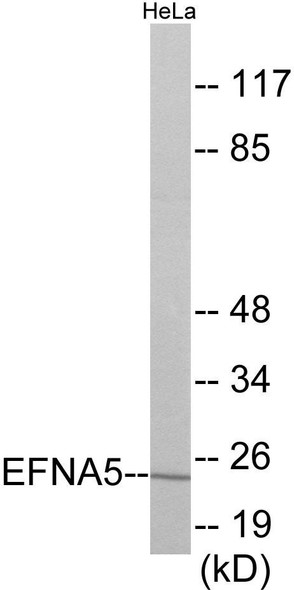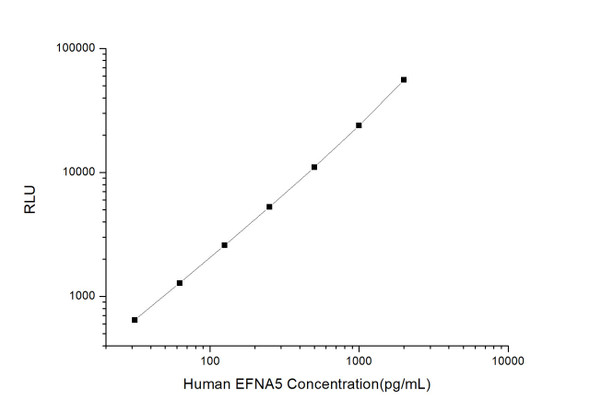Description
| Antibody Name: | Efna5 Antibody (PACO26401) |
| Antibody SKU: | PACO26401 |
| Size: | 50ug |
| Host Species: | Rabbit |
| Tested Applications: | ELISA |
| Recommended Dilutions: | |
| Species Reactivity: | Rat |
| Immunogen: | Recombinant Rat Ephrin-A5 protein (21-203AA) |
| Form: | Liquid |
| Storage Buffer: | Preservative: 0.03% Proclin 300 Constituents: 50% Glycerol, 0.01M PBS, PH 7.4 |
| Purification Method: | >95%, Protein G purified |
| Clonality: | Polyclonal |
| Isotype: | IgG |
| Conjugate: | Non-conjugated |
| Background: | Cell surface GPI-bound ligand for Eph receptors, a family of receptor tyrosine kinases which are crucial for migration, repulsion and adhesion during neuronal, vascular and epithelial development. Binds promiscuously Eph receptors residing on adjacent cells, leading to contact-dependent bidirectional signaling into neighboring cells. The signaling pathway downstream of the receptor is referred to as forward signaling while the signaling pathway downstream of the ephrin ligand is referred to as reverse signaling. Induces compartmentalized signaling within a caveolae-like membrane microdomain when bound to the extracellular domain of its cognate receptor. This signaling event requires the activity of the Fyn tyrosine kinase. Activates the EPHA3 receptor to regulate cell-cell adhesion and cytoskeletal organization. With the receptor EPHA2 may regulate lens fiber cells shape and interactions and be important for lens transparency maintenance. May function actively to stimulate axon fasciculation. The interaction of EFNA5 with EPHA5 also mediates communication between pancreatic islet cells to regulate glucose-stimulated insulin secretion. Cognate/functional ligand for EPHA7, their interaction regulates brain development modulating cell-cell adhesion and repulsion |
| Synonyms: | Ephrin-A5 (AL-1) (EPH-related receptor tyrosine kinase ligand 7) (LERK-7), Efna5, Eplg7 Lerk7 |
| UniProt Protein Function: | Cell surface GPI-bound ligand for Eph receptors, a family of receptor tyrosine kinases which are crucial for migration, repulsion and adhesion during neuronal, vascular and epithelial development. Binds promiscuously Eph receptors residing on adjacent cells, leading to contact-dependent bidirectional signaling into neighboring cells. The signaling pathway downstream of the receptor is referred to as forward signaling while the signaling pathway downstream of the ephrin ligand is referred to as reverse signaling. Induces compartmentalized signaling within a caveolae-like membrane microdomain when bound to the extracellular domain of its cognate receptor. This signaling event requires the activity of the Fyn tyrosine kinase. Activates the EPHA3 receptor to regulate cell-cell adhesion and cytoskeletal organization. With the receptor EPHA2 may regulate lens fiber cells shape and interactions and be important for lens transparency maintenance. May function actively to stimulate axon fasciculation. The interaction of EFNA5 with EPHA5 also mediates communication between pancreatic islet cells to regulate glucose-stimulated insulin secretion. Cognate/functional ligand for EPHA7, their interaction regulates brain development modulating cell-cell adhesion and repulsion (). |
| UniProt Protein Details: | |
| NCBI Summary: | Ephrin-related tryosine-kinase receptor, designated ephrin-A5 based on structure and sequence relationships; implicated in nervous system development, particularly with axon pathfinding and fasciculation [RGD, Feb 2006] |
| UniProt Code: | P97605 |
| NCBI GenInfo Identifier: | 16758778 |
| NCBI Gene ID: | 116683 |
| NCBI Accession: | NP_446355.1 |
| UniProt Secondary Accession: | P97605 |
| UniProt Related Accession: | P97605 |
| Molecular Weight: | 23.2 kDa |
| NCBI Full Name: | ephrin-A5 |
| NCBI Synonym Full Names: | ephrin A5 |
| NCBI Official Symbol: | Efna5 |
| NCBI Official Synonym Symbols: | Lerk7 |
| NCBI Protein Information: | ephrin-A5 |
| UniProt Protein Name: | Ephrin-A5 |
| UniProt Synonym Protein Names: | AL-1; EPH-related receptor tyrosine kinase ligand 7; LERK-7 |
| Protein Family: | Ephrin |
| UniProt Gene Name: | Efna5 |
| UniProt Entry Name: | EFNA5_RAT |






